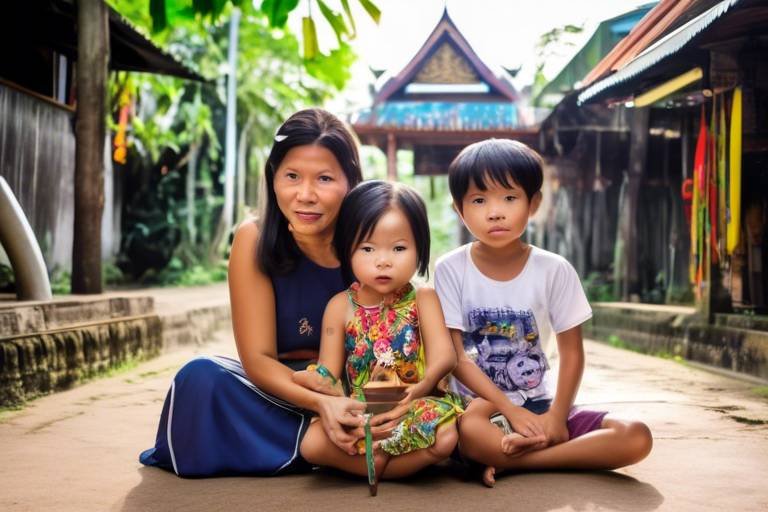Cultural Experiences for Families in Thailand
Exploring Thailand's rich cultural landscape offers families unique opportunities for bonding and learning. This vibrant country, known for its stunning landscapes, delicious cuisine, and warm hospitality, presents a plethora of experiences that cater to all ages. From the bustling streets of Bangkok to the serene temples of Chiang Mai, families can embark on adventures that not only entertain but also educate. Imagine wandering through colorful markets, participating in traditional festivals, or learning to cook authentic Thai dishes together. Each experience is a chance to create lasting memories, strengthen family ties, and foster a deeper understanding of Thailand's diverse culture.
One of the most exciting aspects of visiting Thailand is the ability to immerse oneself in local customs and traditions. Families can participate in lively festivals, such as the water-splashing fun of Songkran or the enchanting lanterns of Loy Krathong. These events are not just celebrations; they are living expressions of Thai culture, filled with joy, community spirit, and opportunities for learning. By joining in these festivities, families can witness firsthand the warmth and friendliness of the Thai people, making their trip even more special.
Moreover, engaging in activities like Thai cooking classes allows families to bond over a shared love for food. Imagine the laughter and teamwork involved in preparing a spicy green curry or a refreshing papaya salad! Not only does this experience teach valuable cooking skills, but it also fosters a sense of accomplishment as families enjoy the fruits of their labor together. The aroma of fresh herbs and spices wafting through the air creates an inviting atmosphere, making it an unforgettable culinary adventure.
To enhance the cooking experience, families can visit local markets, where the sights, sounds, and smells are an adventure in themselves. Picture vibrant stalls overflowing with exotic fruits, fresh vegetables, and aromatic spices. Children can learn about the different ingredients, discover new flavors, and understand the importance of local produce in Thai cooking. It's like a treasure hunt for the senses, encouraging curiosity and exploration.
For a truly unique shopping experience, families should not miss the floating markets, where vendors sell their goods from boats. This picturesque setting allows families to enjoy boat rides while sampling delicious local delicacies. The laughter of children, the sound of water lapping against the boats, and the vibrant colors of fruits and crafts create a magical atmosphere that is sure to be remembered. Additionally, night markets buzz with energy, offering a variety of street foods, crafts, and entertainment. Families can explore together, tasting everything from spicy skewers to sweet desserts while discovering handmade souvenirs to take home.
Another cultural highlight for families is attending traditional Thai dance performances. The colorful costumes and intricate movements tell stories that captivate audiences of all ages. Watching a dance performance is not just about entertainment; it's an enriching experience that sparks interest in the arts and helps families appreciate the beauty of Thai culture.
Lastly, exploring Thailand's stunning temples provides families with a glimpse into the country's spiritual practices and architectural beauty. These visits are not only educational but also encourage respect and understanding of different cultures and beliefs. Guided tours of temples can enhance this experience, as knowledgeable guides share fascinating stories and insights that make each site come alive. Families can learn about the history and significance of these sacred spaces, fostering a deeper appreciation for Thailand's rich heritage.
However, it's essential for families to understand respectful behavior when visiting temples. Learning about dress codes and etiquette is crucial for appreciating Thai customs. This understanding enhances the overall cultural experience for everyone involved, ensuring that families leave with not only memories but also a sense of respect for the traditions they encountered.
- What are the best family-friendly festivals in Thailand? Festivals like Songkran (Thai New Year) and Loy Krathong (Festival of Lights) are great for families, offering fun activities and cultural experiences.
- Are cooking classes suitable for children? Yes! Many cooking classes in Thailand cater to families and include child-friendly recipes, making it a fun experience for all ages.
- What should we wear when visiting temples? It's important to dress modestly, covering shoulders and knees. Many temples provide sarongs for visitors who may not be appropriately dressed.
- How do floating markets differ from night markets? Floating markets are located on water and offer a unique shopping experience, while night markets are bustling street markets filled with food and crafts.

Traditional Thai Festivals
Participating in local festivals allows families to immerse themselves in vibrant traditions, showcasing Thailand's cultural heritage. Imagine splashing water on each other during Songkran, the Thai New Year, where the streets turn into a joyous battlefield of water fights! This festival occurs every April, marking the start of the traditional Thai New Year and is an incredible way for families to bond while enjoying the festive atmosphere. The significance of Songkran goes beyond the fun; it symbolizes the washing away of sins and bad luck, making it a spiritually uplifting experience as well.
Another festival that families should not miss is Loy Krathong, celebrated in November. Picture this: families gather by rivers and lakes, crafting beautiful floating baskets (or krathongs) adorned with flowers, candles, and incense. As night falls, these glowing offerings are released into the water, creating a mesmerizing sight. This act symbolizes letting go of grievances and welcoming new beginnings. It’s a perfect moment for families to reflect together and appreciate the beauty of their surroundings.
Both festivals offer a rich tapestry of experiences that cater to all ages. Children can learn about the significance behind each celebration, while parents can enjoy the lively atmosphere filled with music, dance, and delicious food. Here’s a quick table summarizing some key festivals in Thailand:
| Festival | Date | Highlights |
|---|---|---|
| Songkran | April 13-15 | Water fights, temple visits, and family gatherings |
| Loy Krathong | November (Full Moon) | Floating krathongs, fireworks, and cultural performances |
| Yi Peng | November (Full Moon) | Lantern releases and light displays in Chiang Mai |
Moreover, these festivals often feature traditional music and dance performances that can captivate the entire family. As you stroll through the vibrant streets adorned with colorful decorations, you can indulge in a variety of mouth-watering street foods that reflect the diverse flavors of Thai cuisine. From spicy som tam (papaya salad) to sweet mango sticky rice, there’s something for everyone to enjoy!
So, why not plan your visit around one of these exciting festivals? Not only will you create unforgettable memories, but you’ll also gain a deeper understanding of Thai culture and its values. Festivals in Thailand are not just events; they are a way of life, and participating in them can be a heartwarming experience for families, fostering connections and shared joy.

Thai Cooking Classes
Engaging in a family cooking class in Thailand is not just about learning how to whip up a delicious meal; it’s an adventure that brings everyone together in a fun and interactive way. Imagine the aroma of fresh herbs, the vibrant colors of vegetables, and the sound of sizzling pans filling the air as you and your loved ones dive into the art of Thai cuisine. From the moment you step into the kitchen, the experience becomes a delightful blend of education and enjoyment. You’ll find yourselves laughing, sharing stories, and creating lasting memories while mastering the techniques behind iconic dishes like Pad Thai and Green Curry.
What makes these cooking classes truly special is the opportunity to work as a team. Each family member can take on a role—some can chop vegetables, others can stir sauces, and maybe someone can be in charge of tasting everything (a very important job!). This teamwork not only fosters collaboration but also instills a sense of accomplishment as you all gather around the table to enjoy the fruits of your labor. The joy of sharing a meal that you’ve all contributed to is immeasurable and creates a bond that goes beyond just the cooking experience.
Before diving into the cooking, many classes start with a visit to a local market, which enhances the overall experience. Families can explore the vibrant stalls filled with fresh produce, exotic fruits, and aromatic spices. This market adventure is not only educational but also a sensory delight, as children get to see, touch, and smell ingredients they might have never encountered before. It’s a great opportunity for parents to teach their kids about healthy eating and the importance of using fresh, local ingredients in their cooking.
During these market visits, families can learn about the various ingredients that make Thai food so unique. For instance, did you know that lemongrass is a staple in many Thai dishes? Or that the secret to a great curry lies in the balance of spices? These are just a few of the fascinating tidbits that can make cooking classes even more enriching. The market experience is an integral part of the cooking class, as it not only prepares you for the culinary challenges ahead but also immerses you in the local culture.
One of the most picturesque ways to shop for ingredients is at a floating market. Imagine gliding along the water, surrounded by colorful boats brimming with fresh produce and local delicacies. Families can hop on a boat and sample traditional snacks while purchasing ingredients for their cooking class. It’s a unique experience that combines shopping, sightseeing, and tasting all in one delightful package!
Another thrilling option is to visit night markets, where the atmosphere is electrifying and the food stalls are endless. Families can explore together, tasting various street foods and discovering handmade souvenirs to take home. The vibrant energy of these markets adds an extra layer of excitement to the cooking class experience, making it truly unforgettable.
In summary, Thai cooking classes are more than just a culinary lesson; they are a gateway to understanding and appreciating the rich tapestry of Thai culture. From the bustling markets to the cozy kitchens, every moment is filled with discovery, laughter, and the joy of cooking together as a family. So grab your aprons and get ready to embark on a flavorful journey that will leave you with not just delicious recipes, but also cherished memories.
Q: Do we need prior cooking experience to join a Thai cooking class?
A: No prior cooking experience is necessary! Thai cooking classes are designed for all skill levels, making them perfect for families.
Q: Are the classes suitable for children?
A: Absolutely! Many cooking classes are family-friendly and can be tailored to accommodate younger participants.
Q: What should we bring to the cooking class?
A: Most classes provide all the ingredients and tools you need. However, it's a good idea to wear comfortable clothes and shoes.
Q: Can we take the recipes home?
A: Yes! You will usually receive a copy of the recipes to recreate your favorite dishes at home.

Market Visits
Visiting local markets in Thailand is an experience that transcends mere shopping; it’s a vibrant journey into the heart of Thai culture. Picture this: colorful stalls brimming with fresh produce, aromatic spices wafting through the air, and the lively chatter of vendors and customers alike. For families, exploring these markets is not just about buying ingredients; it’s about creating unforgettable memories together. Imagine the delight on your children's faces as they discover exotic fruits like rambutan and durian, or the excitement of picking out fresh herbs to use in a cooking class later on.
As you stroll through the bustling aisles, you might find yourself surrounded by a kaleidoscope of colors and sounds. Children can learn to appreciate the significance of local produce in Thai cooking, which is often centered around fresh, seasonal ingredients. The experience is both educational and fun, as they can ask questions about different items and even sample some of the delicious street food available at the stalls. For instance, try the som tam (spicy papaya salad) or moo pad krapow (stir-fried pork with basil), which are not only tasty but also showcase the unique flavors of Thai cuisine.
To enhance this experience, families can make a game out of their market visit. Create a list of items to find, turning the outing into a scavenger hunt. This not only keeps the kids engaged but also encourages them to interact with the vendors, practicing their language skills and learning about the importance of community in Thai culture. For example, you can include items like:
- Fresh fruits (like mangoes and lychees)
- Herbs (such as cilantro and basil)
- Local snacks (like kanom krok - coconut pancakes)
Additionally, many markets offer cooking demonstrations or classes, allowing families to see how traditional dishes are prepared. This hands-on approach not only deepens their understanding of Thai culinary traditions but also fosters a sense of teamwork as they work together to create a meal. Ultimately, market visits are an enriching experience that combines learning, bonding, and, of course, delicious food!
Q: What is the best time to visit local markets in Thailand?
A: Most local markets are bustling in the early morning or late afternoon, so plan your visit during these times for the best experience.
Q: Are floating markets different from regular markets?
A: Yes, floating markets are unique as vendors sell their goods from boats, providing a picturesque shopping experience on water.
Q: Can children participate in cooking classes at the markets?
A: Absolutely! Many cooking classes are family-friendly and designed to engage children in the cooking process.

Floating Markets
Imagine gliding through a maze of vibrant colors and enticing aromas, surrounded by the gentle sounds of water lapping against wooden boats. in Thailand offer a truly unique shopping experience that captivates families and creates lasting memories. Here, vendors sell everything from fresh fruits and vegetables to handmade crafts, all while floating on traditional long-tail boats. It's a feast for the senses, and the perfect opportunity to dive into the heart of Thai culture.
One of the most famous floating markets is Damnoen Saduak, located just outside of Bangkok. Families can embark on a boat ride through the bustling canals, where they'll encounter friendly vendors eager to share their goods. The market is especially lively in the early morning, making it an ideal time for families to explore. As you navigate through the waterways, you can sample delicious street food like pad thai and mango sticky rice, or even sip on fresh coconut juice while soaking in the vibrant atmosphere.
Another gem is the Amphawa Floating Market, which is particularly popular in the evenings. This market offers a more local vibe, where families can experience the charm of Thai culture under the glow of lanterns. As you stroll along the wooden walkways, you'll find an array of food stalls serving up mouthwatering dishes that are sure to please even the pickiest eaters. Don't forget to grab a few souvenirs, as many vendors sell handmade crafts that reflect the rich artistry of Thailand.
Visiting floating markets is not just about shopping; it's about creating memories together. Families can bond over trying new foods, learning about local traditions, and even bargaining for unique items. The experience encourages children to appreciate the importance of community and the art of commerce in Thailand. It’s like stepping into a living postcard, where every moment is a snapshot of Thai life.
In addition to the shopping and dining, floating markets often feature live performances and cultural displays that entertain families. From traditional Thai music to dance performances, these activities enrich the experience, providing a deeper understanding of Thai culture. So, whether you're enjoying a boat ride or indulging in local delicacies, floating markets are a must-visit for families looking to immerse themselves in Thailand's vibrant way of life.
- What is the best time to visit floating markets? The best time is early morning for Damnoen Saduak and in the evening for Amphawa Floating Market.
- Are floating markets kid-friendly? Absolutely! Floating markets are fun and engaging for children, with plenty of food and activities to enjoy.
- What type of food can we find at floating markets? You can find a wide variety of Thai street food, including pad thai, som tam (papaya salad), and delicious desserts.

Night Markets
When the sun sets in Thailand, the vibrant energy of the night markets comes alive, creating a magical atmosphere that is perfect for family exploration. Imagine strolling through bustling alleyways filled with colorful stalls, the air rich with the enticing aromas of sizzling street food. Night markets are not just places to shop; they are a celebration of culture and community, where families can bond over delicious snacks and unique finds. Each market has its own personality, offering an array of local delicacies, handmade crafts, and engaging entertainment.
As you wander through the stalls, you might find children marveling at the intricate handicrafts, while parents savor the taste of Pad Thai or Som Tum—a spicy papaya salad that is a must-try. The vibrant lights and sounds create an immersive experience that captivates all ages. From live music performances to traditional dance shows, there’s always something happening that can spark curiosity and joy in children and adults alike.
Night markets also provide an excellent opportunity for families to practice their bargaining skills. Haggling over prices can be a fun game, teaching kids valuable lessons about commerce and negotiation. Plus, it’s a great way to engage with local vendors, who often share stories about their crafts and the ingredients they use in their food. The sense of community is palpable, making it feel like you are part of something bigger—an experience that is both enriching and memorable.
Here are a few popular night markets that families shouldn't miss:
- Chatuchak Weekend Market: Known for its vast selection of goods, from clothing to antiques, this market transforms into a lively night bazaar on weekends.
- Asiatique the Riverfront: A combination of shopping, dining, and entertainment, this market offers a scenic view of the river and hosts a variety of shows.
- Ratchada Train Night Market: Famous for its vibrant atmosphere and diverse food options, this market is a paradise for food lovers.
Whether you're tasting your way through the stalls or picking up a unique souvenir to remember your trip, night markets in Thailand offer an unparalleled experience for families. They not only provide a feast for the senses but also create lasting memories that you and your loved ones will cherish for years to come. So, pack your appetite and your sense of adventure, and get ready to dive into the heart of Thailand’s night market culture!
Q1: What is the best time to visit night markets in Thailand?
A1: The best time to visit night markets is typically after sunset, around 6 PM to 10 PM, when the atmosphere is lively and the stalls are fully operational.
Q2: Are night markets family-friendly?
A2: Absolutely! Night markets are very family-friendly, with plenty of food options, entertainment, and shopping opportunities that cater to all ages.
Q3: What should we bring to a night market?
A3: It's a good idea to bring cash, as many vendors do not accept credit cards. Also, wear comfortable shoes, as you will likely be walking around a lot!
Q4: Can we find vegetarian options at night markets?
A4: Yes, many night markets offer a variety of vegetarian and vegan options, making it easy for everyone to find something delicious to eat.

Traditional Dance Performances
Attending a traditional Thai dance performance is like stepping into a vibrant tapestry of history and culture, where every movement tells a story. Families can enjoy the mesmerizing spectacle of dancers adorned in colorful costumes that reflect the rich heritage of Thailand. These performances are not just entertainment; they are a window into the soul of the nation, showcasing the intricate art forms that have been passed down through generations.
Imagine sitting in a beautifully decorated theater, the air filled with the sweet scent of jasmine as the lights dim. The stage comes alive with dancers who move gracefully, their bodies telling tales of ancient legends and folklore. The intricate choreography and the melodious sounds of traditional instruments create an atmosphere that captivates both young and old. It’s an experience that ignites curiosity and appreciation for Thai culture, making it a perfect family outing.
One of the most popular forms of traditional dance is the Khon dance, which often depicts stories from the epic Ramakien. Families can marvel at the elaborate masks and costumes worn by the performers, each symbolizing different characters. The rhythmic movements and expressive gestures are not only visually stunning but also convey deep emotions, allowing the audience to connect with the stories being told. This is where a child's imagination can truly flourish, as they visualize the battles and romances unfolding before their eyes.
Another captivating performance is the Classical Thai Dance, which is characterized by its graceful movements and delicate hand gestures. Families can appreciate the skill involved, as dancers train for years to perfect their art. It's fascinating to see how each gesture has a specific meaning and contributes to the overall narrative. This art form encourages children to explore their own creativity and perhaps even inspire them to take up dance lessons themselves!
For families looking to deepen their understanding, many venues offer pre-show talks or workshops. These sessions provide insights into the history and significance of the dances, making the experience even more enriching. Imagine the delight on your children's faces when they learn about the stories behind the performances and the cultural values they represent!
In addition to the performances, families can often find opportunities to interact with the dancers. Some venues allow for meet-and-greet sessions where children can ask questions and learn about the dedication required to become a performer. This personal connection adds a special touch to the experience and fosters a deeper appreciation for the art.
Overall, attending traditional Thai dance performances is not just about watching; it's about engaging with the culture, understanding its roots, and creating lasting memories as a family. Whether it's the vibrant costumes, the enchanting music, or the compelling stories, these performances offer a unique way for families to bond and learn together.
- What types of traditional dance performances can families attend in Thailand?
Families can enjoy various performances, including Khon, Classical Thai Dance, and folk dances that showcase different regions of Thailand. - Are there family-friendly venues for watching traditional dances?
Yes, many theaters and cultural centers cater to families, often providing engaging pre-show talks and workshops. - How can we prepare our children for a traditional dance performance?
Discuss the stories behind the dances, encourage them to observe the details in costumes and movements, and perhaps watch videos of performances beforehand. - Can we meet the dancers after the performance?
Many venues offer meet-and-greet opportunities where audiences can interact with the performers, ask questions, and learn more about the art form.

Temple Visits
Exploring Thailand's stunning temples is like stepping into a vibrant tapestry of history, spirituality, and architectural marvels. Each temple, or wat, is not just a place of worship but a treasure trove of stories waiting to be uncovered. Families visiting these sacred spaces can engage in a unique cultural experience that transcends mere sightseeing. Imagine walking through the grand entrance of Wat Pho, where the majestic reclining Buddha lies, or standing in awe before the intricate designs of Wat Arun, the Temple of Dawn, which sparkles beautifully as the sun rises. These visits are not only educational but also create a sense of wonder and appreciation for the rich traditions that define Thai culture.
As families explore these sacred sites, they often discover fascinating aspects of Thai spirituality and community life. The intricate murals, stunning architecture, and serene gardens provide a backdrop for learning about the significance of Buddhism in Thai society. Children can ask questions about the statues and symbols they see, fostering curiosity and dialogue. For instance, many temples feature guardian spirits and mythical creatures that can spark imaginative stories, making the experience both fun and enlightening.
To enhance your temple visits, consider opting for guided tours. These tours often provide insights that you might miss when exploring on your own. Knowledgeable guides share captivating tales about the history of each temple, the stories behind the intricate carvings, and the significance of various rituals. This can be particularly engaging for children, who are likely to remember the colorful anecdotes and fascinating facts. Here’s a quick overview of what families might learn during a guided temple tour:
| Temple Name | Key Features | Interesting Facts |
|---|---|---|
| Wat Pho | Reclining Buddha, Traditional Thai Massage School | Home to the largest collection of Buddha images in Thailand. |
| Wat Arun | Stunning River Views, Intricate Porcelain Design | Known as the Temple of Dawn, it’s beautifully illuminated at sunset. |
| Wat Phra Kaew | Emerald Buddha, Grand Palace | Houses the most revered Buddha image in Thailand. |
While visiting these temples, it's crucial for families to understand the importance of respectful behavior in sacred spaces. This includes adhering to dress codes, such as wearing clothing that covers shoulders and knees, and removing shoes before entering certain areas. Teaching children about these customs not only enhances their appreciation for Thai culture but also instills values of respect and mindfulness. It’s like teaching them the unwritten rules of a game; knowing how to behave enhances the overall experience for everyone involved.
In conclusion, temple visits in Thailand are not just about observing beautiful architecture; they are about immersing oneself in a culture rich with history, spirituality, and community. Families can bond over shared discoveries, engage in meaningful conversations, and create lasting memories that go beyond the typical tourist experience. So, whether you're marveling at the intricate details of a temple or participating in a local ceremony, each moment spent in these sacred spaces is a step towards understanding and appreciating the beautiful tapestry that is Thailand.
- What should I wear when visiting a temple? It's important to wear modest clothing that covers your shoulders and knees. Many temples provide sarongs for visitors who may not be appropriately dressed.
- Are children allowed in temples? Yes, children are welcome in temples. In fact, visiting temples can be a great educational experience for them.
- Can I take photos inside the temples? Photography policies vary by temple. Always check for signs indicating whether photography is allowed, especially in sacred areas.

Guided Tours
Opting for of Thailand's magnificent temples is like stepping into a living history book, where each page is filled with stories waiting to be uncovered. Imagine walking through the ancient halls of Wat Phra Kaew, the Temple of the Emerald Buddha, or exploring the intricate details of Wat Pho, home to the famous reclining Buddha. With a knowledgeable guide leading the way, families can delve deeper into the significance of these sacred spaces, making the experience not only educational but also incredibly engaging for both kids and adults.
One of the great advantages of guided tours is the opportunity to learn about the rich history and cultural significance of each temple. Guides often share fascinating anecdotes and legends that bring the temples to life, transforming a simple visit into an unforgettable adventure. For example, did you know that the Emerald Buddha is not just a beautiful statue but also a symbol of Thai royalty? Such insights can spark curiosity in children and adults alike, making them eager to learn more about the culture.
Moreover, guided tours often include interactive elements that engage the entire family. Many guides encourage questions, allowing children to express their curiosity and learn in a fun, dynamic way. This interaction can lead to spontaneous discussions about Thai traditions, beliefs, and even the architectural styles that define these magnificent structures. Families can bond over shared discoveries, making the tour a memorable experience that goes beyond mere sightseeing.
In addition to the educational aspect, guided tours also help families navigate the sometimes overwhelming landscapes of these temple complexes. With so many intricate details and hidden gems, it can be easy to miss out on the best parts. A good guide will ensure that you get the most out of your visit, pointing out unique features and explaining their significance. For instance, they might lead you to a lesser-known shrine where families come to make wishes, providing an intimate glimpse into local customs.
To make the most of your guided tour experience, consider these tips:
- Choose a reputable tour company: Look for companies with good reviews and knowledgeable guides.
- Ask questions: Don’t hesitate to inquire about anything that piques your interest.
- Respect local customs: Be mindful of dress codes and behavior while visiting sacred sites.
Ultimately, guided tours offer families a unique opportunity to connect with Thailand's cultural heritage in a meaningful way. By learning together, sharing experiences, and exploring the depths of Thai spirituality and artistry, families can create lasting memories that will be cherished for years to come.
1. What should we wear when visiting temples in Thailand?
It’s important to dress modestly when visiting temples. Both men and women should cover their shoulders and knees. Many temples provide sarongs or shawls for visitors who may not be appropriately dressed.
2. Are guided tours expensive?
The cost of guided tours can vary widely depending on the length, inclusions, and the tour company. However, many consider it a worthwhile investment for the enriched experience and knowledge gained.
3. How long do guided tours typically last?
Most guided tours last between 2 to 4 hours, but this can depend on the specific itinerary and the number of sites visited.
4. Can children join guided tours?
Absolutely! Many guided tours are family-friendly and designed to engage children with interactive elements and stories.

Respectful Behavior
When visiting Thailand's magnificent temples, it's crucial for families to embrace the essence of . These sacred spaces are not just architectural wonders; they are places of worship and cultural significance. Understanding and adhering to the local customs enhances your experience and shows appreciation for Thai traditions. So, what are the key aspects families should keep in mind?
First and foremost, dressing appropriately is essential. Most temples have strict dress codes to maintain the sanctity of the environment. This typically means covering shoulders and knees. For women, wearing a long skirt or dress and a shawl can be a great option, while men should opt for long pants and a t-shirt. It's always a good idea to check specific temple guidelines before your visit. Imagine walking into a serene temple only to be met with disapproving looks because of your outfit! It’s like showing up to a formal dinner in your pajamas—definitely not the right vibe.
Additionally, removing shoes before entering temple grounds is a common practice. This is a sign of respect and helps keep the sacred space clean. Families can turn this into a fun little ritual; perhaps even make a game out of who can put their shoes on the fastest once they leave! Remember, this is not just a rule; it’s a cultural norm that reflects the deep respect Thais have for their spiritual sites.
Another important aspect is behavior inside the temple. Speaking softly and refraining from loud laughter or boisterous conversations shows respect for those who are there to pray or meditate. It’s like being in a library—everyone is there to soak in the atmosphere, and keeping the noise down helps everyone enjoy the experience. Encourage your kids to observe and appreciate the peacefulness around them. You might be surprised at how much they can learn just by being still for a moment!
Lastly, when interacting with locals, especially monks, it’s vital to maintain a respectful distance. Monks are revered figures in Thai society, and approaching them too closely or touching them can be seen as disrespectful. Instead, families can take a step back and admire their serene presence. It’s a great opportunity to teach children about personal space and the importance of respecting others' beliefs and customs.
In summary, practicing respectful behavior while visiting temples in Thailand is a wonderful way for families to engage with the culture. From dressing appropriately to maintaining a quiet demeanor, these actions not only enhance your experience but also foster a deeper understanding of Thai traditions. So, gear up for an enlightening adventure, and remember that respect is the key to unlocking the full beauty of these sacred spaces!
- What should we wear when visiting temples in Thailand?
It's best to wear clothing that covers your shoulders and knees. Women can wear long skirts or dresses, while men should opt for long pants and t-shirts.
- Are there any specific behaviors we should avoid in temples?
Avoid loud conversations, touching monks, and taking photos in restricted areas. Always be mindful of the peaceful atmosphere.
- Can we take photos inside the temples?
Many temples allow photography, but some may have restrictions. Always check for signs or ask a local if you're unsure.
Frequently Asked Questions
- What are some must-see traditional Thai festivals for families?
Families should definitely check out Songkran, the Thai New Year, where water fights and cultural activities abound. Loy Krathong is another enchanting festival, celebrated with floating lanterns and beautiful decorations, perfect for creating lasting memories together.
- Are cooking classes suitable for kids?
Absolutely! Many cooking classes in Thailand cater to families and offer kid-friendly options. It's a fun way for children to learn about Thai cuisine while also developing teamwork skills, making it a deliciously educational experience!
- What can we expect at a floating market?
Floating markets are a visual treat! Families can enjoy boat rides while sampling local delicacies. Expect to see vibrant stalls filled with fresh produce, handcrafted goods, and a lively atmosphere that truly reflects Thai culture.
- How should we behave when visiting temples?
Respect is key! It's important to dress modestly, covering shoulders and knees, and to be quiet and respectful inside temple grounds. Learning about these customs enhances your family's appreciation of Thai culture and traditions.
- Are guided tours of temples worth it?
Definitely! Guided tours provide insightful knowledge about the history and significance of each temple. A knowledgeable guide can share fascinating stories that captivate both kids and adults, making the experience much more enriching.
- What types of souvenirs can we find at night markets?
Night markets are treasure troves of unique finds! From handmade crafts and clothing to delicious snacks, families can explore a variety of souvenirs to remember their trip by. It's a great way to bring a piece of Thailand back home!



















